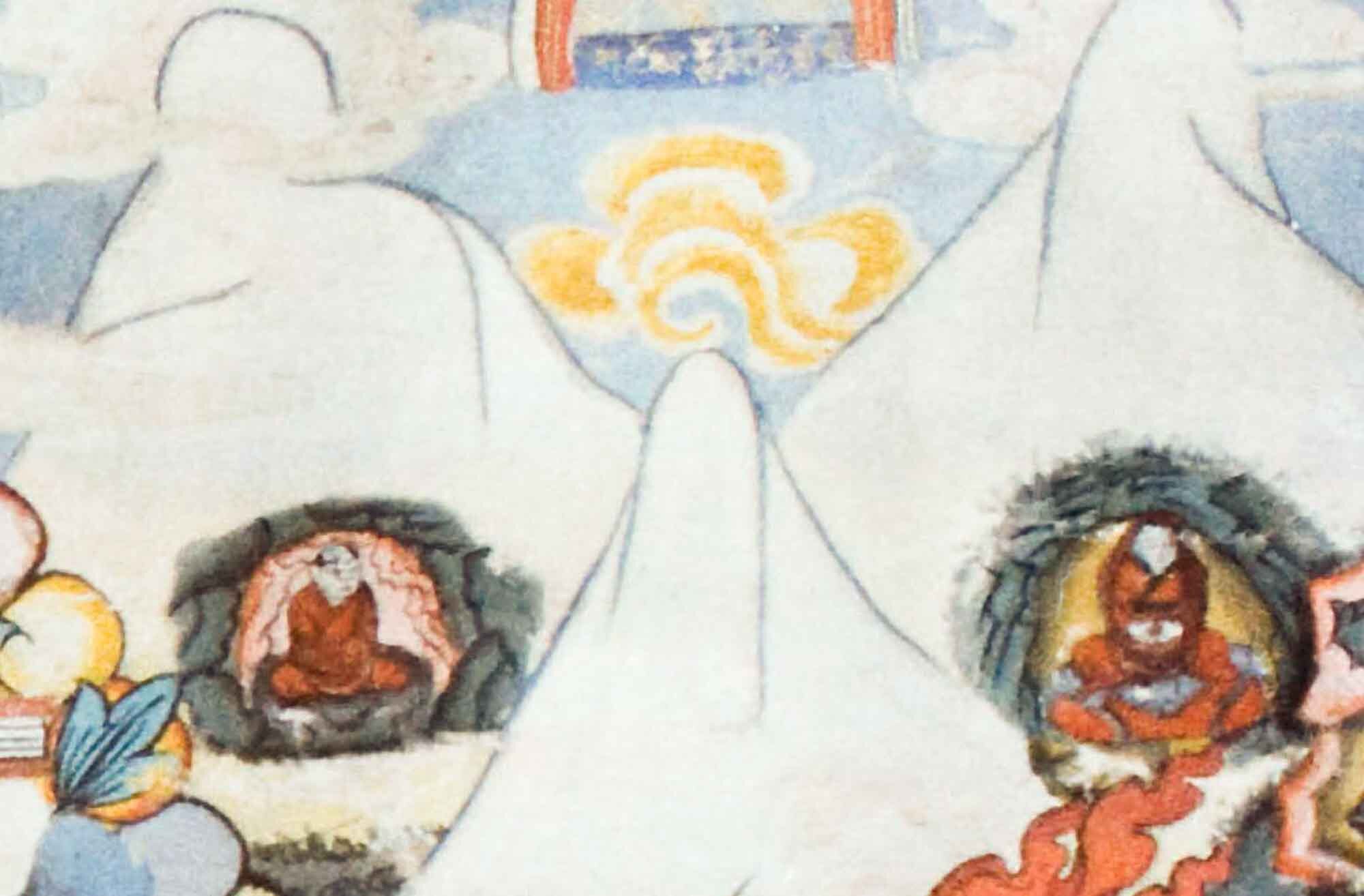Jamyang Khyentse Chökyi Lodrö (1893–1959) is widely regarded as the most outstanding Tibetan master of the twentieth century. An authority on all traditions and holder of all lineages, he was at the heart of the Rimé (non-sectarian) movement. Urgyen Sangharakshita met him in 1957 in Kalimpong not long after the Rinpoche had arrived, after fleeing Tibet the previous year. From him Sangharakshita received the Mañjughoṣa, Avalokiteśvara, Vajrapāṇi and Tārā initiations or sādhanas. He kept Rinpoche’s photograph on his shrine and usually another one on his desk or on a small table next to his armchair.
“My first impression of Jamyang Khyentse Rimpoche was that he was very much a monk. With his closely cropped white hair, long ear lobes, and deeply lined face, he indeed looked more like a Burmese mahāthera or ‘great elder’ than a Tibetan incarnate lama.… He sat cross-legged on a kind of throne made up of three or four big, square Tibetan cushions placed one on top of another; in front of him was a narrow table on which were arranged a dorje and bell, a pot with a long, curved spout, a small pot filled with rice, and other ritual implements. On the guru’s left, on a single cushion, sat ‘the Ḍākinī’, as she was respectfully called, and on her left, also on a single cushion, sat the Maharani of Sikkim. On the right of the guru were his personal attendant, another monk, Kachu Rimpoche, and my good Dharma-friend Sonam Topgay Kazi. My place was immediately in front of the Rimpoche.”
Precious Teachers, The Complete Works of Sangharakshita, vol. 22, pp.399 & 402
Mañjughoṣa thangka
This thangka was painted for Sangharakshita on the instructions of Jamyang Khyentse Rinpoche, following initiation by him on 24 October 1957.
“The first gift was a thangka or painted scroll, resplendent with the traditional border of rich Chinese brocade and mounted on rollers. The big central figure was that of a saffron-coloured Mañjughoṣa, who with his right hand whirled aloft a flaming sword of insight while with his left he grasped the stem of a white lotus flower on whose open petals rested a sacred book, understood to be that of the Perfection of Wisdom. He was flanked on his right by a white, four-armed Avalokiteśvara, and on his left by a dark blue Vajrapāṇi in his wrathful form. Below Mañjughoṣa was Green Tārā, and above him, in three tiers, a couple of dozen human teachers of whom I recognized only the Buddha and Milarepa. Two wrathful deities, one blue and one red, occupied, respectively, the left-hand and right-hand bottom corners of the painting, while to the right of the book of the Perfection of Wisdom there was a range of snow-covered mountains. In two of the mountains there was a cave, and in each cave sat a tiny yellow-robed figure.
“The painting was not so well executed as he could have wished, Jamyang Khyentse told me, though it was the work of the best artist he had been able to find in Gangtok; and indeed, the work was clumsily if painstakingly done, the rays of rainbow light that emanated from Mañjughoṣa’s body terminating in a ring of solid-looking rainbow balls. But I was too deeply moved by the Rimpoche’s kindness in giving me the thangka, which had been painted in accordance with his directions, to be much concerned about any shortcomings it might have. Moreover, there was a special significance in his giving me the thangka. As he proceeded to explain, through the initiations he had given me he had transmitted to me the essence of the teachings of the great masters who were depicted in it. I was now their spiritual heir and successor. Smiling, he then pointed to the yellow-robed figures in their caves, one meditating and one teaching. Both were me.”
Precious Teachers in The Complete Works of Sangharakshita vol. 22, pp.406–7
The original of the thangka is in Bombay with the ‘Society of the Servants of God’. Sangharakshita asked them in 1962 to look after it for him for the time being.
Initiation texts from Jamyang Khyentse Rinpoche in red wooden arabesque cover boards
These are the texts of the four sādhanas of the initiation that Jamyang Khyentse Rinpoche performed for Sangharakshita on 24 October 1957. The handwritten texts and the wooden arabesque covers were commissioned for Sangharakshita by the Maharani Queen of Sikkim, who knew him from his several visits to their Gangtok Palace. She was a big supporter of Jamyang Khyentse and was also a recipient of the initiations.
“In order to practise the sādhanas I would need to have the texts describing them, and these the Maharani undertook to provide.”
Precious Teachers in The Complete Works of Sangharakshita, vol. 22, pp.402
Diary entry for 24 October 1957










